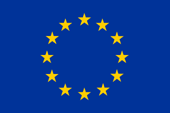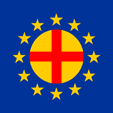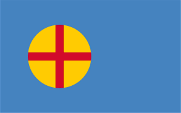Europäische Union
|
|
|
|
| Übersicht – Contents: | |
Diese Seite ist Teil des Projektes
Europäische Union
|
|
|
|
| Übersicht – Contents: | |
Flagge – Flag: |
|
 |
Flagge der EU |
| 1986 hat sich der Rat auf die Europäische Flagge geeinigt, die zum Emblem der Europäischen Union wurde. Sie zeigt einen Kranz von zwölf goldenen fünfstrahligen Sternen, deren Spitzen sich nicht berühren, auf kobaltblauem Hintergrund, als Zeichen der Union der Völker Europas. Da die Zahl Zwölf als Symbol für Vollkommenheit und Einheit gilt, ist sie unveränderlich. Die zwölf Sterne stehen somit nicht für die Anzahl der Mitgliedsstaaten. Die Farben sind im Leitfaden der Europäischen Kommission von 1996 und im Leitfaden des Europarats von 2004 entsprechend geregelt, und zwar als Blau = CMYK 100|80|0|0, was Pantone Reflex Blue entsprechen würde und als Gelb = CMYK 0|21|100|0, was Pantone 123 entsprechen würde. | In 1986
the European Council get agreed about the European flag, which became to the
emblem of the European Union. It shows twelve golden five-pointed stars in
form of a circle on cobalt blue ground as symbol of the union of the peoples
of Europe. The number of stars is unchangeable. Twelve is the symbol of perfection and unity. That means that this cipher stands not for the number of members in the union.The colours are regulated accordingly in the European Commission's Guide of 1996 and the Council of Europe's Guide of 2004, as Blue = CMYK 100|80|0|0, which would correspond to Pantone Reflex Blue, and as Yellow = CMYK 0|21|100|0, which would correspond to Pantone 123. |
| Quelle: Wikipedia (EN) | |
Flaggengeschichte – Flag History: |
|
 |
Flagge der Paneuropa Bewegung, |
 |
Von Richard Graf von Coudenhove-Kalergi im Jahre 1952 vorgeschlagene Flagge für Europa |
| Richard Graf von Coudenhove-Kalergi, ein politischer Schriftsteller, * 16.11.1894 Tokio, † 27.07.1972 Schruns (Vorarlberg), war der Gründer und Generalsekretär der Paneuropabewegung. Neben vielen Schriften zur europäischen Einigung schuf er in den zwanziger Jahren des 19. Jahrhunderts die Paneuropaflagge. Sie war quadratisch und trug ein rotes Kreuz inmitten einer goldene Scheibe, umgeben von einem Kranz aus zwölf goldenen fünfzackigen Sternen, auf einem dunkelblauen Grundtuch. | Richard
Count of Coudenhove-Kalergi, a political author, * 16th of November 1894 in
Tokio, † 27th of July 1972 in Schruns (Vorarlberg), was the founder and
Secretary General of the Pan Europe Movement. In addition to many works about the European unification he created in the twenties of the 19th century the Pan Europe Flag. It was quadratic and carryed a red cross amid a golden disk, surrounded by a wreath of twelve golden vive-pointed stars on a dark blue bunting. |
| Nach der
Gründung des Europarats im Jahre 1949 wurden verschiedene Vorschläge für
eine Flagge für diese Organisation gemacht. Coudenhove-Kalergi schlug im
Jahre 1952 eine Flagge vor, die derjenigen der Paneuropabewegung ähnlich
war, jedoch trug sie nicht die zwölf Sterne. Auf Grund ihres christlichen
Erscheinungsbildes wurde sie von der Türkei abgelehnt. (siehe auch diesen Link beim Europarat selbt: https://www.coe.int/en/web/documents-records-archives-information/european-flag), Quelle: Volker Preuß |
After the
establishment of the European Council in the year 1949 were made various
proposals for a flag for this organization. Coudenhove-Kalergi proposed in
the year 1952 a flag, which was similar to those of the Pan Europe Movement,
but it did not carry the twelve stars. Because of its Christian appearance
it was rejected by Turkey. (look this link at the European Council itself: https://www.coe.int/en/web/documents-records-archives-information/european-flag), Source: Volker Preuß |
| Paul M. G. Lévi, der Leiter der Kulturabteilung des Europarats, schuf Anfang der 50-er Jahre eine Flagge für den Europarat. Er schlug zunächst eine Flagge vor die derjenigen der Paneuropabewegung ähnlich war. Jedoch enthielt sie nicht mehr die goldene Scheibe und das Kreuz, und die Anzahl der Sterne hatte sich auf fünfzehn erhöht. Diese sollten die Mitgliedsstaaten im Europarat repräsentieren. Da dieses Konzept das Saarland (als eigenständiges Mitglied des Europarates) mit eingeschlossen hätte, lehnte Deutschland diesen Entwurf ab. | Paul M. G. Lévi, the chief of the department of culture of the European Council created in the beginning of the fifties a flag for the European Council. He proposed initially a flag which was similar to those of the Pan Europe Movement. But it contained anymore the golden disk and the cross and the number of the stars was heightened to fifteen. Those should represent the states which are members in the European Council. Because that concept should have included the Saarland as an independent member of the European Council Germany rejected this draft. |
| Seit seiner Gründung im Jahre 1949, war sich der Europarat der Notwendigkeit bewusst, Europa ein Symbol zu geben, mit dem sich seine Einwohner identifizieren können. Am 25.10.1955 fiel in der Parlamentarischen Versammlung die einstimmige Entscheidung einen Kreis goldener Sterne auf blauem Hintergrund als Emblem anzunehmen. Am 08.12.1955 nahm das Ministerkomitee dieses als die Europäische Flagge an: | Since its
establishment in the year 1949, the European Council saw the need to give
Europe a symbol wherewith Europes inhabitants could identify. On 25th of October in 1955 the parliamentary congregation passed the unanimous decision to adope as emblem a circle of golden stars on blue ground. On 8th of December in 1955 the minister's committee adoped the following as the European flag: |
| Am blauen Himmel der Westlichen Hemisphäre, repräsentieren die Sterne die Völker Europas in einem Kreis, das Symbol der Einheit. Ihre Anzahl soll immer zwölf sein, das Symbol für Vollkommenheit und Vollendung. So wie die zwölf Tierkreiszeichen das gesamte Universum repräsentieren, stehen die zwölf goldenen Sterne für alle Völker Europas, diejenigen eingeschlossen, die noch nicht am Bau Europas in Einheit und Frieden teilhaben können. | On the
blue sky of the western hemisphere the stars represent the nations of Europe
in a circle, the symbol of unity. Their number has to be always twelve, the
symbol of perfection and finishing. In the same way like the twelve signs of the Zodiac represent the whole universe stand the twelve golden stars for all nations of Europe – including those which still can not participate in the construction of Europe in unity and peace. |
| Am
11.4.1983 nahm das Europäische Parlament diese Flagge als das offizielle
Symbol für die Europäische Union an. Quelle: Peter Diem, Media Research, Wien, peter-diem.at/, gestützt auf offizielle Texte des Europarates und zeitgenössische Medienberichte |
On 11th
of April in 1983 the European parliament adoped that flag as the official
symbol for the European Union. Source: Peter Diem, Media Research, Vienna, peter-diem.at/, based on official scripts of the European Council and contemporary media reports |
| Über die Motivation und den Antrieb der in die Europäische Flaggengeschichte verwickelten Personen gibt es recht unterschiedliche Darstellungen. Drei von diesen sollen hier kurz präsentiert werden: | About the
motivation and the stimulus of the in the European flag history engaged
persons there are quite different descriptions. Three of them should be briefly exhibited here: |
|
|
|
|
|
|
| Quelle: Jörg Roggenbuck | Source: Joerg Roggenbuck |
|
|
| Quelle: Mared Gwyn Jones, Euronews Deutsch, 15.07.2025, Text, Video | |
| Während Richard Graf von Coudenhove-Kalergi (1894–1972) in einer persönlichen Erklärung bekräftigte, dass drei führende Katholiken innerhalb des Europarats "unterbewusst" die zwölf Sterne nach dem Vorbild der biblischen "Apokalypse des Johannes" (Offenbarung 12,1) gewählt hätten, erklärte Paul M. G. Lévi, Pressebeamter des Europarats von 1949 bis 1966, im Jahre 1989, dass es keine religiösen Intentionen – oder was auch immer damit verbunden wird – bei der Auswahl des Kreises mit den zwölf Sternen gegeben habe. Die Zahl Zwölf wurde als Symbol für Vollkommenheit and Beständigkeit ausgewählt. | When
Richard Count of Coudenhove-Kalergi (1894–1972) confirmed in a personal
statement that three high-ranking Catholics in the European Council elected
"subconsciously" the twelve stars by the model of the biblical "Apocalypse
of Johannes" (Revelation 12,1), announced Paul M. G. Lévi – press
functionary of the European Council between 1949 and 1966 – in the year 1989
that there were none religious intentions – or whatever will be linked with
it – at the choose of the circle with the twelve stars. The number twelve
was picked as the symbol for perfection and stability. |
| Quelle: Peter Diem, Media Research, Wien, peter-diem.at/ | Source: Peter Diem, Media Research, Vienna, peter-diem.at/ |
Landkarte – Map: |
Landkarte der Mitgliedsstaaten – Map of the member states: |
|
|
| Zahlen und Fakten – Numbers and Facts: | |
|
|
|
|
|
|
|
|
|
|
|
|
1951 Der Weg zur Europäischen Union hat 1951 begonnen. Damals gründeten sechs
westeuropäische Staaten in Paris die Europäische Gemeinschaft für Kohle und
Stahl (EGKS). Es waren: Belgien, die Bundesrepublik Deutschland, Frankreich,
Italien, Luxemburg und die Niederlande. Sie hatten von Anfang an Größeres
vor, als nur einen gemeinsamen Markt für Kohle und Stahl zu bilden. Im
Gründungsvertrag heißt es, die sechs Staaten seien entschlossen, "durch die
Errichtung einer wirtschaftlichen Gemeinschaft den ersten Grundstein für
eine weitere und vertiefte Gemeinschaft unter Völkern zu legen, die lange
Zeit durch blutige Auseinandersetzungen entzweit waren". |
1951 The way to the European Union startet in 1951. At that time established six
western European states in Paris the European Community for Coal and Steel
(ECCS). It were: Belgium, the Federal Republic of Germany, France, Italy,
Luxembourg and the Netherlands. They planed right from the beginning more
than only a common market for Coal and Steel. In the founding treaty is
signifyed that the six states are resolved "to place the first foundation
stone for a further and heighten community under the nations which were
divided for long times by bloody quarrels by the establishment of an
economic community". |
| Quelle: Volker Preuß |
| Das Wort "Europa" hat seine Wurzeln im semitischen Wort "Ereb", was "Abend" heißt. Europa ist das "Abendland". | The word "Europe" has its roots in the semitic word "Ereb", what means "evening". Europe is the "Land of Eve". |
| Quelle/Source: Handbuch der geographischen Namen | |